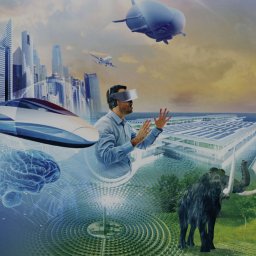2016 was a wonderful year for both – developers and users of augmented and virtual reality experiences. Some studies declared 2016 as the year of AR/VR due to a number of changes and shifting trends. In fact, it has It has led to the rise of a new ecosystem of startups and business models.
Have a look at some statistics:
– Total sales of virtual and augmented reality devices will soar from 2.5 million in 2015 to 24 million by 2018 (CCS Insight)
– Over 12 million VR headsets are projected to be sold in 2017 whereas the sales of AR smart glasses are expected to be worth $1.2 billion. (CCS Insight)
– Revenue from augmented reality will hit a whopping $100 billion mark by 2020 (State of AR 2016).
– On Angel List, there are 1083 companies describing themselves in the VR category on AngelList while 336 startups list themselves under AR.
– AR/VR could hit $150bn in revenue by 2020 – with AR taking around $120 billion and VR $30 billion (Digi-Capital)
2017 is gaining momentum and will be a productive year for the augmented reality and virtual reality. The stakes are high and many of the big companies are evolving the need of VR and AR.
In this article, we have listed predictions about emerging trends in the virtual reality and augmented reality in 2017.
1. AR & VR beyond Gaming & Entertainment
The head of virtual and augmented reality at Infosys, Vishwa Ranjan predicts that VR will fade away. He believes, companies will view virtual reality and augmented reality as legitimate technologies that they should be investing and researching in.
The technologies should not be limited to games and entertainment purpose only. Despite being the backbone of the gaming industry, companies will shift towards VR and AR for the customer, and enterprise purpose, keeping in view the day-to-day connection and potential in work and processes.
“In 2017, we will overcome this problem. 360 video-based apps will be the primary drivers of these content-driven technologies with a focus on surveillance, collaboration, and telepresence” – he believes
2. Custom VR Content will become the Mainstream
Another AR expert, Hamza Abbas foresees a hike in enterprise-based customer designed VR content in 2017. The demand for VR reality content as a knowledge-sharing tool will be the main driver allowing users to connect with a completely mesmerizing environment, whether it be a classroom, virtual showrooms, property development or operating theaters.
The demand will be hyped with more accessible Virtual Reality Systems, introduced to the market. Google Daydream is one of the examples of Android-based open source platform for mobile virtual reality.
With a number of new headsets and platforms, content creators will have to make sure the Virtual Reality market lives up to its potential next year.
3. Use in Healthcare
Healthcare is a very big market, and there is a big untapped potential for AR and VR. In the near future, we’ll see growing number of companies integrating AR/VR into healthcare segments.
Virtual Reality’s groundbreaking potential is beyond entertainment. In 2017, there would be an addition to it, which will be healthcare. Presently, the VR work is going through the development phase, and much has been seen as a way to treat patients suffering from anxiety disorders, he said.
Virtual Reality – through recent scientific development in the brain and mind could become a more frequent element in various areas of healthcare, which would result in enhancing surgical outcomes to pain management to applications not yet imagined.
4. Augmented Reality Will Be More in Use
Though both AR and VR are growing, AR is getting more share of the pie. AR plays a big role to bring content, interactions with customers and services. The nature of augmented reality, blanketing the real world with digital content, helps in driving interaction with a customer in a physical space to display a wide a variety of products.
Consumers will be capable of seeing anything they want from a wide range of sources with sales representatives presenting the product, without being present at a given location.
5. Marketing Personalization Tool
Yes, AR and VR are now part of the modern marketing. According to Jamie Merrick, the head of industry insights at Salesforce Commerce, augmented and virtual realities would be developed into digital concept stores, linking the online, mobile and in-store channels together, to depict a unified experience for customers.
The personalized approach will make it easier for shoppers to find the required product from any location to visualize how it looks or fit.
Conclusion
The rising popularity of AR and VR have laid a very strong foundation for growth in 2017 and the years ahead. Companies are shifting towards augmented reality and virtual reality to transform the customer experiences.
IQVIS AR/VR Solutions:
If you’re a business and intend to present your products or services via AR/VR, OR you are looking for a dedicated AR/VR solution – get in touch with IQVIS. We’ve helped a number of startups in developing their core AR products and features and can do the same for you.



